Artículo
Aeolian sediment mass fluxes on a sandy soil in Central Patagonia
Peri, Pablo Luis ; Parigiani, Jacopo; Cittadini, Eduardo Daniel; Peters, Piet; Scholberg, Johannes; Peri, Pablo Luis
; Parigiani, Jacopo; Cittadini, Eduardo Daniel; Peters, Piet; Scholberg, Johannes; Peri, Pablo Luis
 ; Parigiani, Jacopo; Cittadini, Eduardo Daniel; Peters, Piet; Scholberg, Johannes; Peri, Pablo Luis
; Parigiani, Jacopo; Cittadini, Eduardo Daniel; Peters, Piet; Scholberg, Johannes; Peri, Pablo Luis
Fecha de publicación:
07/2012
Editorial:
Elsevier Science
Revista:
Catena
ISSN:
0341-8162
Idioma:
Inglés
Tipo de recurso:
Artículo publicado
Clasificación temática:
Resumen
The climate of Patagonia is semi-arid and characterized by frequent strong winds. Wind erosion is potentially a serious soil degradation process that impacts long-term sustainability of local agricultural systems, but the conditions and the rates of wind erosion in this region have not been studied extensively. The aim of this study was to quantify windblown mass transport on a sandy soil in Central Patagonia. Aeolian mass fluxes were measured in the valley of Sarmiento (Chubut province, Argentina) using two saltiphones and 24 Modified Wilson and Cooke (MWAC) sediment catchers. The latter were installed along three transects: (1) a control on a bare strip of land cleared of its natural vegetation, to measure the maximum wind erosion; (2) a similar transect protected by an artificial windbreak with an optical porosity of 50%; and (3) a transect in a cherry orchard protected with the same type of windbreak. Nine windstorms were recorded throughout the experimental period. Storms with wind speed peaks of 20 m s-1 caused a total soil loss of 248 ton ha-1 in the control strip and heavily depleted the soil of its erodible fraction. The artificial windbreak reduced the soil loss by 51.0% on average, while no erosion was recorded in the cherry orchard. Measured maximum mass transport values were used to fit five sediment transport equations in order to select the best equation to integrate into a GIS-based wind erosion prediction system. The Kawamura (1964) equation showed the highest model efficiency and was considered to be the best sediment transport equation for the Patagonia conditions. It expresses total mass transport as a function of two empirical constants: the threshold friction velocity ( ), and an erodibility coefficient . It is concluded that wind erosion in Central Patagonia poses a serious risk of soil degradation once the natural vegetation is removed due to overgrazing or other anthropogenic activities.
Archivos asociados
Licencia
Identificadores
Colecciones
Articulos(SEDE CENTRAL)
Articulos de SEDE CENTRAL
Articulos de SEDE CENTRAL
Citación
Peri, Pablo Luis; Parigiani, Jacopo; Cittadini, Eduardo Daniel; Peters, Piet; Scholberg, Johannes; et al.; Aeolian sediment mass fluxes on a sandy soil in Central Patagonia; Elsevier Science; Catena; 95; 7-2012; 112-123
Compartir
Altmétricas



